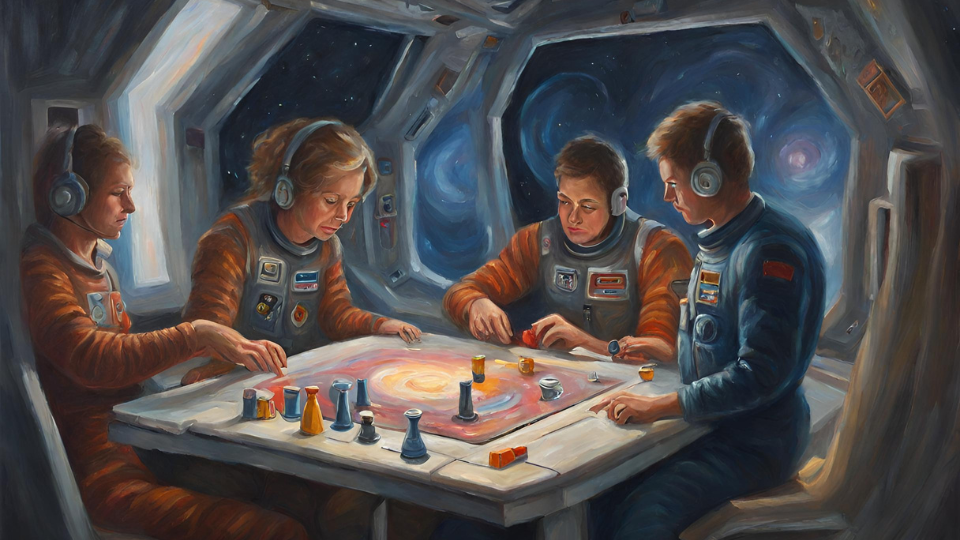
Retrospectives are meetings where IT humans reflect on how the sprint went and share what they learned from it.
However, they don’t have to be all work and no play.
You can also add a bit of fun to the equation by conducting games that encourage collaboration, creativity, and communication and make the whole process more enjoyable.
The best part is that you can use these games at different times throughout the scrum cycle, from the beginning of your project until its end.
Let’s dive into this topic together!
Table of Contents
Explorers, shoppers, vacationers, prisoners (ESVP)
ESVP is a popular game that can be played at the start of retrospectives.
In this game, each participant reports their attitude towards the retrospective as either explorer, shopper, vacationer, or prisoner.
Explorers are optimistic and excited about the things they’ll learn from the retrospective.

Get unreal data to fix real issues in your app & web.
Shoppers are interested in finding out what’s going on and being part of the group.
Vacationers come just to get away from work for a while but aren’t really interested in improving anything.
Prisoners don’t want to be there; they only come because they’ve been mandated to attend by their team leader or peers.

To start the game, have the facilitator write down all four options on paper and pass it around the room so people can respond anonymously by picking the option they can relate to the most.
Then, when everyone has had time to respond, look at the results and see what kind of feedback you get.

If your team has a good mix of explorers and shoppers, with only a couple of vacationers and prisoners, things are going pretty well.
If there are almost no explorers or shoppers with lots of prisoners, then something is probably holding your team back from working at their full potential.
Symbolic sprint game
A good way to begin a retrospective is with a symbolic sprint game.
In a nutshell, it’s a fun and engaging activity that gets people in the mood for a discussion about what went well and what didn’t in the last sprint and what can be improved in the next iteration.
In this activity, you ask everyone to describe the latest sprint as if it were a movie title, an action hero or villain, or even a historical event.

For example, if team members were working on making the launch of a mobile application go smoothly, you might get answers like: The Final Countdown, Bumpy Road to Release, The Sprint from Hell, The Great Crash, The Road to Recovery, and so on.
The idea behind this game is to get developers thinking creatively about the sprint and make them feel comfortable talking about their experiences—which is a great ice breaker for the retrospective.
Since retrospectives are all about learning from past experiences and improving future ones, this kind of warm-up activity is great for bringing everyone together and setting the tone for the rest of the retrospective.
One word retrospective
At the beginning of the retrospective, you can also try an activity called One word.
The participants are asked to use one word to describe how they feel about the last sprint, write that word on a sticky note and post it on a whiteboard.
Then, each participant explains why they wrote the word or just shares the word itself if they prefer not to explain it in front of the group.
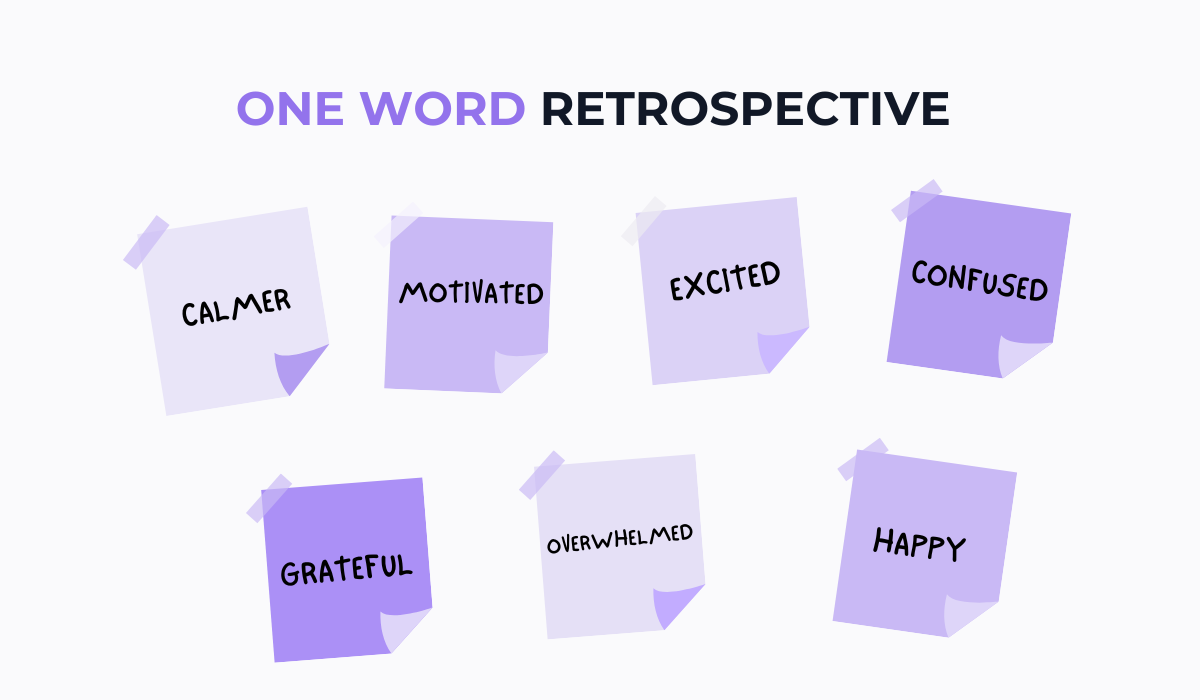
As in the picture, you can expect words such as confused, overwhelmed, happy, motivated, excited, and so on.
You can also ask your team members to talk about how that word made them feel and why they chose that particular word.
This can generate great conversations about what developers liked or didn’t like about the sprint and let you dig into topics that would have been difficult to discuss without setting this relaxed tone first.
Two truths and a lie
This is a game that’s especially fun for scrum teams that are already working well together.
With this game, you can get a feel for how your team members view the team, but it can also be used as a diagnostic tool.
Here’s how it works.
Each team member shares three statements about the team, sprint, or anything else they want to talk about.
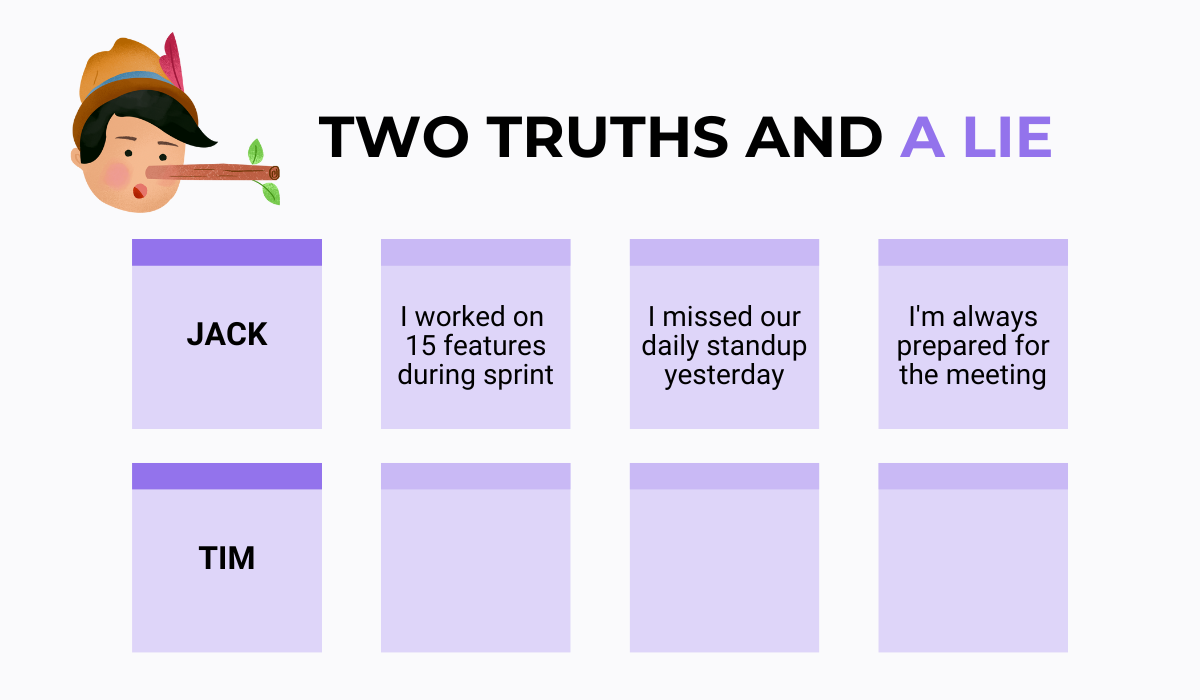
Two of those statements should be true, and one should be false.
For example, as in the picture above, one statement could be: “I worked on 15 features.” While another could be: “I missed our daily standup yesterday.” And another: “I’m always prepared.”
After that, the rest of the team guesses which statement is false.
This can lead to some interesting discussions among team members as they try to figure out what isn’t true.
Keep an eye on the statements that are discussed the most–these will often illuminate areas where there are contradictory feelings or friction within the team.
Those can be good places for reflection and communication between teammates.
Mad sad glad
If you’ve been on a scrum team, you might be familiar with the game Mad sad glad.
It’s usually played at the end of a sprint to collect feedback, but it’s also a good way to get an idea of what people think in general about the process or the team.
The game starts by asking everyone to write things that make them mad, sad, and glad on a piece of paper or sticky notes.
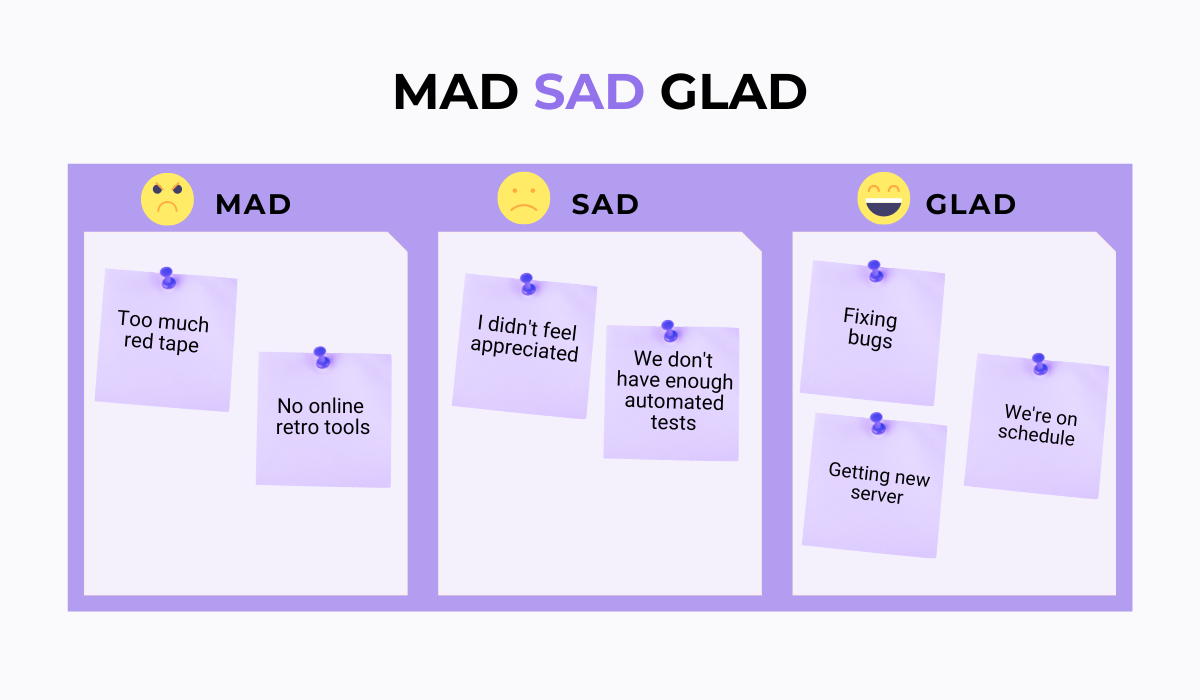
The team then looks at the statements on the list and discusses them.
For example, some of the answers can be next:
- I’m mad that there’s too much red tape.
- I’m sad that we don’t have more automated tests.
- I’m glad we’re finally getting a new server.
Of course, these examples are here just to give you a better understanding of the game. You’ll get a completely different set of answers from your team.
However, keep in mind that this game is not for pointing fingers or finding fault with individuals.
The purpose of this game is to get people talking about the problems and successes of the sprint and also to brainstorm ideas for future sprints.
Draw the sprint
Sprints can be grueling, and sometimes it’s hard to know how your team is doing.
Game Draw the sprint can be a fun, simple, and not-too-serious way to get your team to reflect, especially if you’re in a time crunch and don’t have time for more in-depth reviews.
The facilitator hands each person pieces of paper and markers and sets up a whiteboard somewhere in the room.
Then they start asking questions such as:
- How did you feel this during iteration?
- What was the highlight of it?
- What was the biggest issue?
- What would you change?
Each person draws their answer on the piece of paper; then puts them on the board so everyone can see what they have drawn.

Before discussing the answers, team members try to guess them from the drawings.
This way, you’ll get a good insight into how your teammates interpret things differently about the project, which can lead to exciting discussions.
This exercise can also help you identify things that need improvement with clarity and specificity—and it’s easy to do at any point during a sprint!
Constellation Retrospective
You may have already had a few retrospective meetings, but you might not be getting the results you want.
Constellation is a simple exercise in getting everyone in the same room at the same time to discuss their experiences with issues currently faced in the project.
In this exercise, an object is placed in the middle of the room. This object can be anything: an apple, a book, or even just a marker.
Team members are then asked to move in and out of the circle based on what they agree and disagree with.
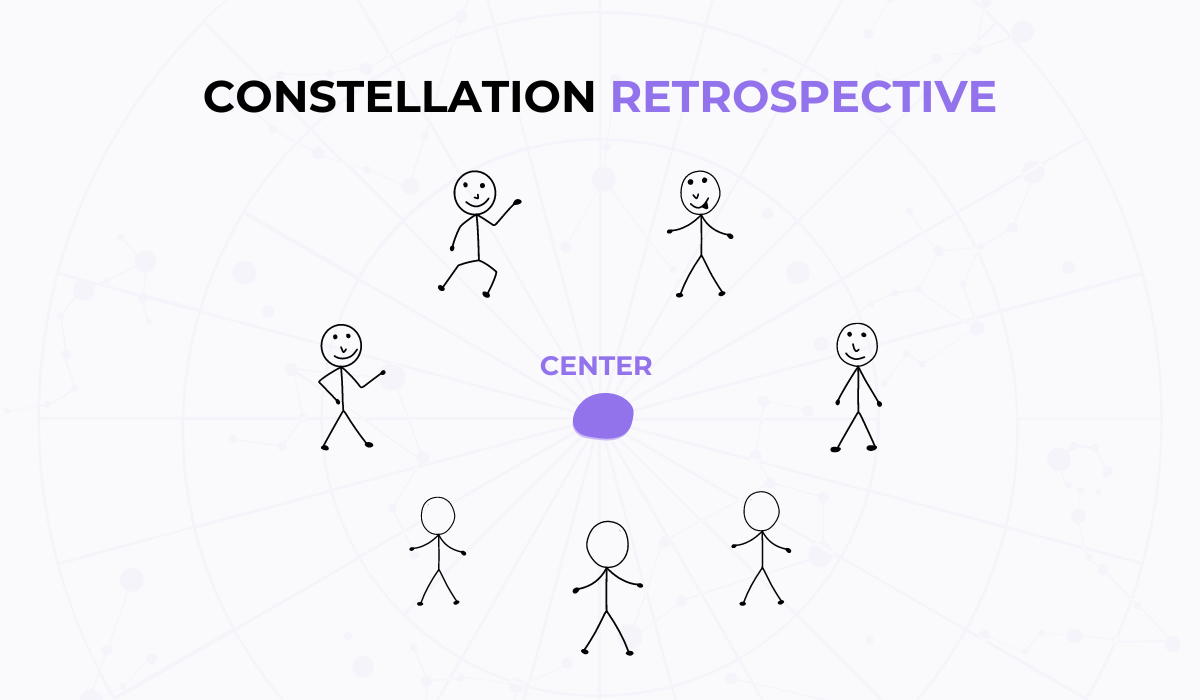
The statements can be anything as they depend on your project and the team.
However, we’ll list a few of them to give you an idea of what kind of statements you can use during your constellation retrospective:
- I like being a part of this team.
- I am satisfied with the quality of our code.
- I think we have too many retrospectives.
Many teams use this exercise because it’s a great way to get a pulse on how team members feel about the retrospective process.
This activity will help you uncover any major pain points that need to be addressed.
You can also ask each person why they moved in or away—this will lead to a more focused discussion about what needs improvement.
Kudo cards wall
The Kudo cards wall is a simple way to boost your team’s morale.
It’s a great activity to do at the end of a sprint or after a long project when you want to recognize the things your team is doing well.
The idea is to ask people to write down a Kudo card to acknowledge a fellow teammate on some of the traits they embody.
The only prerequisite is that these messages are positive and encouraging, not negative or critical in any way.
Once everyone has submitted their cards, you put them on a wall or board for everyone to see.

The cards can be about anything—as simple as “Anna gives the best advice,” or more elaborate, like “Anna made an excellent presentation about our new mobile app today.”
This game is meant to be a quick team-building activity that can be conducted in less than 15 minutes, which makes it ideal for short feedback sessions.
The goal is to create a positive environment that encourages your team to share appreciation and acknowledge each other’s good work.
Three little pigs
Three Little Pigs is an engaging way to open up a conversation about your process.
As you probably already guessed, the inspiration came from a story about three pigs who built houses to protect themselves from danger.
The first pig builds his house from straw, and the wolf blows it down.
The second pig tried to build his structure with sticks but shared the same destiny as the first pig when the wolf came.
The third pig builds his house out of bricks, which withstands the wolf’s attack.
The activity uses this classic tale to test the foundations of the projects and sprints.

First, the facilitator draws three columns for three types of houses and explains them to the team members, followed by the questions such as:
- What do we do that’s a bit shaky but still works?
- What do we do that has a decent foundation but could be even better?
- What structures are built really well?
Participants share their remarks by writing them on sticky notes and placing them under one of the three columns.
Based on these comments, you can quickly identify some key areas that have a weak foundation and could use more solid construction.
Return on time invested
Return on time invested is a simple assessment meant to help agile teams evaluate whether their retrospectives are effective and bring results.
As a team, you’ll want to maximize your productivity and make sure you spend your time wisely.
And the data you’ll get from this activity will allow you to compare the time the team spends on retrospective activities with the actionable results that come from it.
To start, after the retrospective, ask your team members to indicate how useful and actionable it was in detecting issues, collecting feedback, and overall organization.
After that, make a chart showing your team’s meeting ratings.

Explain to the group that you won’t discuss the chart to encourage more honest feedback.
You will simply use this information to make comparisons in the future.
In other words, this chart is most useful when you compare it to charts from previous retrospectives and use it to monitor positive or negative trends.
SMART action
In retrospectives, developers often discuss issues and define new strategies to fix them or prevent them from reoccurring.
However, these strategies are not always followed through.
Why is this? Because they’re not actionable.
The SMART action aims to give people a format to create an action list from all the suggestions discussed.

Capture, Annotate & Share in Seconds with our Free Chrome Extension!
SMART stands for Specific, Measurable, Achievable, Realistic, and Time-based.
By ensuring your goals meet these criteria, you can avoid vague, abstract goals like “improve the process” or “make better decisions.”
The basic game plan is simple: right after the retrospective meeting—or maybe even before it—share an image of SMART goals with your team.
This will help everyone understand the concept.
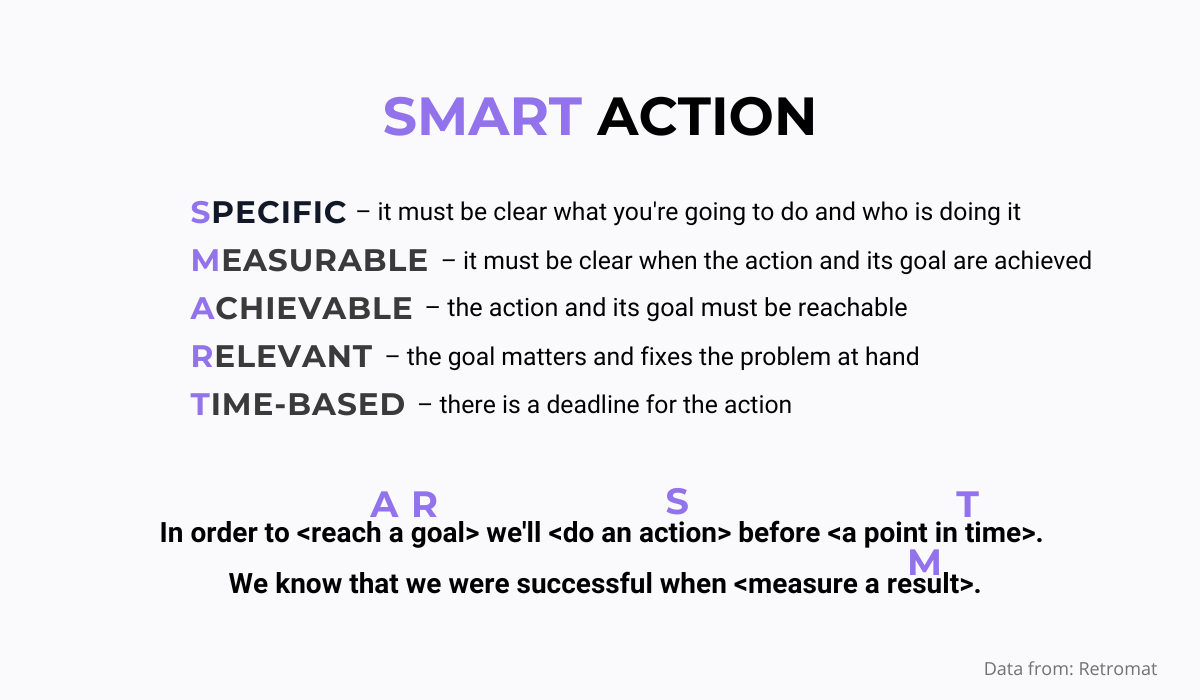
After that, ask each team member to suggest SMART actions that will help the team perform better during the next sprint.
Collect all the SMART actions you discussed in one place, group them by similarity and prioritize the ones you want to tackle next.
Save a list of these actions for your next retrospective to discuss with your team what worked and what didn’t.
Having SMART actions in place will make your retrospective meetings more productive because everyone will know exactly what they need to do to accomplish the goals.
SMART actions are something every serious development team does. For example, DECODE agency teams are always relying on SMART actions. That and some other similar actions are what make them stand out in software development.
Letters to the future
Letters to the future is a simple yet powerful way to start a retrospective.
This game is meant to help your team think beyond the current issues and see the bigger picture.
It’s a way to focus on the positive and imagine how you want things to turn out.
The idea is simple—ask participants to write a letter about their performance so far or about how they expect their performance to go by some future date (one month or three months).
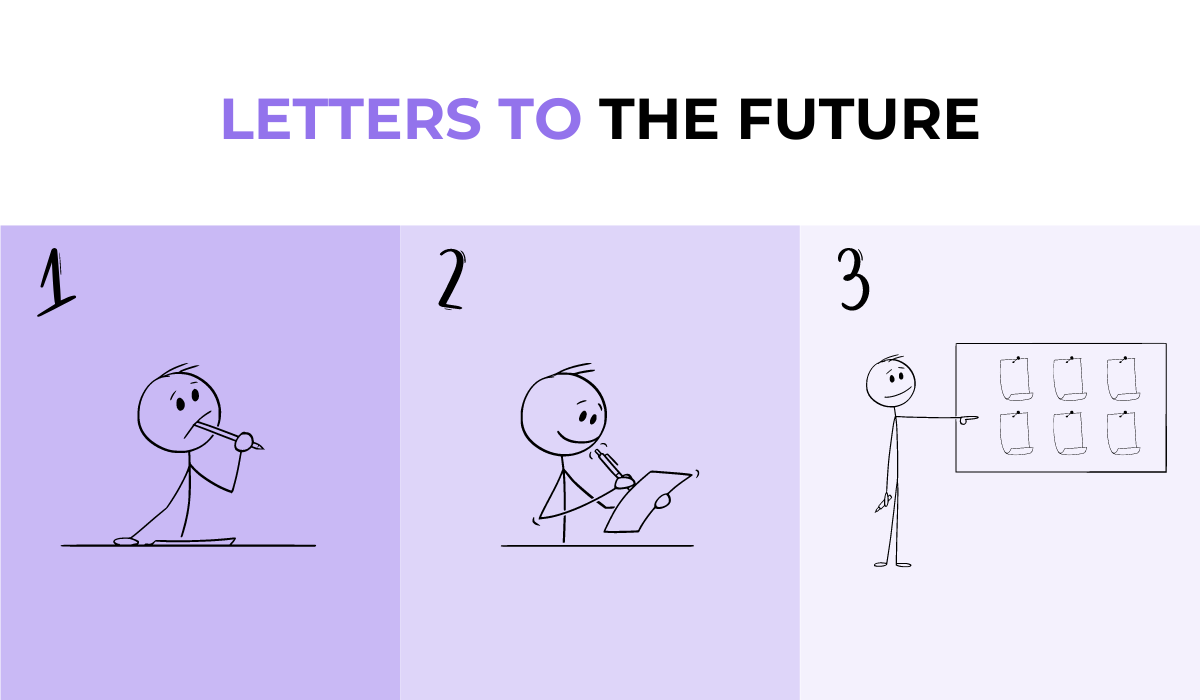
Encourage them to write in a positive light and focus on achievements and outcomes instead of describing problems.
Then, keep these letters private until you’re done with your project.
After the project is finished, read the letters, and ask your team to share which elements from their letters came true.
This will allow your team members to reflect on where they were during the project and how far they’ve come.
Plus, it’ll help them appreciate how much they’ve already achieved.
Conclusion
There are many different types of games that you can conduct in your retrospectives.
Each game is unique in its own way and will help you focus on a specific set of issues to work through with your team members afterward.
Whether it’s a specific behavior you want to address with an individual or a broader issue with how team members communicate with each other, there’s a game that will fit perfectly with what you’re trying to achieve.
We hope our list of fun retrospective games has given you a few ideas for your retrospective meetings.
